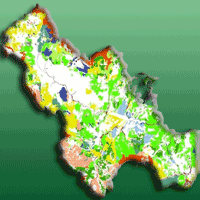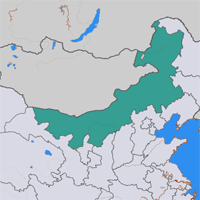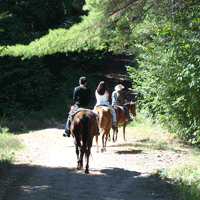Sustainable forest management usually involves the use of criteria and indicators (C&I) allowing the monitoring, reporting and assessment of management activities at national, regional and forest management unit levels. Experiences of such concepts are scarce in Nepal, particularly with regard to the evaluation of management activities within a Multi-Criteria Analysis (MCA) framework. In this contribution we describe how a MCA approach can be used to efficiently exploit information, knowledge, and preferences of stakeholders to address community forest management problems. Beside rating and ranking techniques, the Analytic Hierarchy Process (AHP) is used to examine the importance of six criteria and forty-four indicators in a sustainable forest management context with a broad range of stakeholder groups. An evaluation of four management strategies in the Shree Gyneshwar community forest user group allows to demonstrate the relevance of changing priorities for different criteria. A passive adaptive management strategy focusing on a multiple use of natural resources and the introduction of production-oriented measures were identified as the most preferable option. The results of this study show that the multi-criteria analysis approach, and in particular the AHP, can assist decision-makers in efficiently evaluating management problems and generating ideas for the long-term strategic planning process of community forest management, even under complex socio-economic and ecological conditions. In that context, compromise solutions enjoy a higher possibility of being successful, taking into account the different views of stakeholder groups.
Keywords
, , , , ,
Citation
Khadka C, Vacik H (2012). Use of multi-criteria analysis (MCA) for supporting community forest management. iForest 5: 60-71. - doi: 10.3832/ifor0608-009
Academic Editor
Marco Borghetti
Paper history
Received: Oct 02, 2011
Accepted: Feb 12, 2012
First online: Apr 12, 2012
Publication Date: Apr 30, 2012
Publication Time: 2.00 months
© SISEF - The Italian Society of Silviculture and Forest Ecology 2012
Open Access
This article is distributed under the terms of the Creative Commons Attribution-Non Commercial 4.0 International (https://creativecommons.org/licenses/by-nc/4.0/), which permits unrestricted use, distribution, and reproduction in any medium, provided you give appropriate credit to the original author(s) and the source, provide a link to the Creative Commons license, and indicate if changes were made.

Breakdown by View Type
(Waiting for server response...)
Article Usage
Total Article Views: 65317
(from publication date up to now)
Breakdown by View Type
HTML Page Views: 52851
Abstract Page Views: 4715
PDF Downloads: 6200
Citation/Reference Downloads: 54
XML Downloads: 1497
Web Metrics
Days since publication: 5003
Overall contacts: 65317
Avg. contacts per week: 91.39
Article Citations
Article citations are based on data periodically collected from the Clarivate Web of Science web site
(last update: Mar 2025)
Total number of cites (since 2012): 25
Average cites per year: 1.79
Publication Metrics
by Dimensions ©
Articles citing this article
List of the papers citing this article based on CrossRef Cited-by.
(1)
Allen CR, Fontaine JJ, Pope KL, Garmestani AS (2011)Adaptive management for a turbulent future. Journal of Environmental Management 92 (5): 1339-1345.
CrossRef |
Gscholar
(2)
Ananda J, Herath G (2005)Evaluating public risk preferences in forest land-use choices using multi-attribute utility theory. Ecological Economics 55 (3): 408-419.
CrossRef |
Gscholar
(3)
Antunes P, Santos R, Videira N (2006)Participatory decision making for sustainable development: the use of mediated modelling techniques. Land Use Policy 23 (1): 44-52.
CrossRef |
Gscholar
(4)
Armitage D, Berkes F, Doubleday N (2007)Adaptive co-management. Collaboration, learning and multilevel governance. University of British Columbia Press, Vancouver, BC, Canada.
Gscholar
(5)
Belton S, Stewart TJ (2002)Multiple criteria decision analysis. An integrated approach. Kluwer Academic Publishers, Massachusetts, USA.
Gscholar
(6)
Birkhof J (2003)Community conflict over water reuse. Perspectives from conflict analysis and resolution. Appendix C: Water reuse. In: “Understanding public perception and participation” (Hartley TW ed). Water Environment Research Foundation, Alexandria, VA, USA.
Gscholar
(7)
Blahna DJ, Yonts’-Shepard S (1989)Public involvement in resource planning: toward bridging the gap between policy and implementation. Society and Natural Resources 2 (1): 209-227.
CrossRef |
Gscholar
(8)
Bojórquez-Tapia LA, Sánchez-Colon S, Florez A (2005)Building consensus in environmental impact assessment through multicriteria modeling and sensitivity analysis. Environmental Management 36 (3): 469-481.
CrossRef |
Gscholar
(9)
Bolton M (1975)Royal Chitwan National park management plan, 1975-79. Project Working Document No. 2, HMG/UNDP/FAO National Parks and Wildlife Conservation Project, Kathmandu, Nepal.
Gscholar
(10)
Buck LE, Geisler CC, Schelhas J (2001)Biological diversity: balancing interests through adaptive collaborative management (Wollenberg E ed). CRC Press, New York, USA.
Gscholar
(11)
Carpenter S (1991)Solving community problems by consensus. Program for community problem solving, Washington, DC, USA.
Gscholar
(12)
Corona P, Scotti R (2011)Systemic silviculture, adaptive management and forest monitoring perspectives. L’Italia Forestale e Montana 66: 219-224.
CrossRef |
Gscholar
(13)
Dhar A, Ruprecht H, Vacik H (2008)Population viability risk management (PVRM) for
in-situ management of endangered tree species: a case study on a
Taxus baccata L. population. Forest Ecology Management 255 (7): 2835-2845.
CrossRef |
Gscholar
(14)
Friedmann J (1973)Retracking America: a theory of transactive planning. Anchor Press, Garden City, New York, USA.
Gscholar
(15)
Fürst C, Volk M, Makeschin F (2010)Squaring the circle? Combining models, indicators, experts and end-users in integrated land-use management support tools. Environmental Management 46 (6): 829-833.
CrossRef |
Gscholar
(16)
Glück P (1995)Criteria and indicators for sustainable forest management in Europe. Working Group S6, XX IUFRO World Congress, Tampere, Finland.
Gscholar
(17)
Gray B (1989)Collaborating: finding common ground for multiparty problems. Jossey-Bass Publishers, San Francisco, CA, USA.
Gscholar
(18)
Gregory RS (2000)Valuing environmental policy options: a case study comparison of multiattribute and contingent valuation survey methods. Land Economics 76 (2): 151.
CrossRef |
Gscholar
(19)
Herath G (2004)Incorporating community objectives in improved wetland management: the use of the analytic hierarchy process. Journal of Environmental Management 70 (3): 263-273.
CrossRef |
Gscholar
(20)
Hilborn R, Walters CJ (1992)Quantitative fisheries stock assessment: choice, dynamics and uncertainty. Kluwer Academic Publishers, Boston, Dordrecht, London.
CrossRef |
Gscholar
(21)
Hjortsø CN, Stræde S, Helles F (2006)Applying multi-criteria decision-making to protected areas and buffer zone management: a case study in the Royal Chitwan National Park, Nepal. Journal of Forest Economics 12 (2): 91-108.
CrossRef |
Gscholar
(22)
Holling CS (1978)Adaptive environmental assessment and management. John Wiley and Sons, London, UK.
Gscholar
(23)
ITTO (1992)Guidelines for the sustainable management of natural tropical forests. International Tropical Timber Organization, Yokohama, Japan.
Gscholar
(24)
ITTO (1993)Guidelines for the establishment and sustainable management planted tropical forests. International Tropical Timber Organization, Yokohama, Japan.
Gscholar
(25)
Iversen V, Chhetry B, Francis P, Gurung M, Kafle G, Pain A, Seeley J (2006)High value forests, hidden economies and elite capture: evidence from forest user groups in Nepal’s terai. Ecological Economics 58 (1): 93-107.
CrossRef |
Gscholar
(26)
Jentoft S (1985)Models of fishery development. Marine Policy 9 (4): 322-331.
CrossRef |
Gscholar
(27)
Kangas J (1999)The analytic hierarch process (AHP): standard version, forestry application and advances. In: “Multiple use of forests and other natural resources” (Helles F, Holten-Andersen P, Wichmann L eds). Kluwer Academic Publishers, Dordrecht, The Netherlands, pp. 96-105.
CrossRef |
Gscholar
(28)
Kangas A, Laukkanen S, Kangas J (2006)Social choice theory and its applications in sustainable forest management’ a review. Forest Policy and Economics 9 (1): 77-92.
CrossRef |
Gscholar
(29)
Kangas A, Saarinen N, Saarikoski H, Leskinen LA, Hujala T, Tikkanen J (2010)Stakeholder perspectives about proper participation for Regional Forest Programmes in Finland. Forest Policy and Economics 12 (3): 213-222.
CrossRef |
Gscholar
(30)
Keeney RL, Raiffa H (1976)Decisions with multiple objectives: performances and value trade-offs, Wiley, New York, USA.
Gscholar
(31)
Khadka C, Vacik H (2008)Applying adaptive collaborative management for social learning: a case study of community forestry in Nepal. Journal of Universal Computer Science (J.UCS), pp. 101-108;
Gscholar
(32)
Khadka C, Vacik H (2012)Comparing a top-down and bottom-up approach in the identification of criteria and indicators for sustainable community forest management in Nepal. Forestry 85 (1): 145-158.
CrossRef |
Gscholar
(33)
Lindenmayer DB, Likens GE, Haywood A, Miezis L (2011)Adaptive monitoring in the real world: proof of concept. Trends in Ecology and Evolution 26 (12): 641-646.
CrossRef |
Gscholar
(34)
Linkov I, Satterstrom F, Kiker G, Batchelor C, Bridges T, Ferguson E (2006)From comparative risk assessment to multi-criteria decision analysis and adaptive management: Recent developments and applications. Environment International 32 (8): 1072-1093.
CrossRef |
Gscholar
(35)
Mahanty S, Fox J, Nurse M, Stephen P, McLees L (2006)Hanging in the balance: equity in community based natural resource management in Asia. RECOFTC and East-West Centre, Bangkok, Thailand.
Gscholar
(36)
Malczewski J, Moreno-Sanchez R, Bojorquez-Tapia L, Ongay-Delhumeau E (1997)Multicriteria group decision-making model for environmental conflict analysis in the Cape Region, Mexico. Journal of Environmental Planning and Management 40 (3): 349-374.
CrossRef |
Gscholar
(37)
Mardle S, Pascoe S, Herrero I (2004)Management objective importance in fisheries: an evaluation using the Analytic Hierarchy Process (AHP). Environmental Management 33 (1): 1-11.
CrossRef |
Gscholar
(38)
Martins H, Borges JG (2007)Addressing collaborative planning methods and tools in forest management. Forest Ecology and Management 248 (1-2): 107-118.
CrossRef |
Gscholar
(39)
Maser C (1996)Resolving environmental conflict: toward sustainable community development. St. Lucie Press, Delray Beach, Florida, USA.
Gscholar
(40)
McDonald-Madden E, Baxter PW, Fuller RA, Martin TG, Game ET, Montambault J, Possingham HP (2010)Monitoring does not always count. Trends in Ecology and Evolution 25 (10): 547-550.
CrossRef |
Gscholar
(41)
McDougall C, Kaski ACM Team, NewERA ACM Team, Forest Action (2007)Planning for the sustainability of forests through adaptive co-management: Nepal country report. ACM Project/MoFSC Internal Research Report, CIFOR, Bogor, Jawa Barat, Indonesia.
Gscholar
(42)
MCPFE (1993)Ministerial conference on protection of forests in Europe. Conference Proceedings. Ministry of Agriculture and Forestry, Helsinki, Finland.
Gscholar
(43)
Mendoza G, Martins H (2006)Multi-criteria decision analysis in natural resource management: a critical review of methods and new modelling paradigms. Forest Ecology and Management 230 (1-3): 1-22.
CrossRef |
Gscholar
(44)
Mendoza GA, Prabhu R (2000)Multiple criteria decision making approaches to assessing forest sustainability using criteria and indicators: a case study. Forest Ecology and Management 131 (1-3): 107-126.
CrossRef |
Gscholar
(45)
Mendoza GA, Prabhu R (2003)Qualitative multi-criteria approaches to assessing indicators of sustainable forest resource management. Forest Ecology and Management 174 (1-3): 329-343.
CrossRef |
Gscholar
(46)
Mendoza GA, Prabhu R (2005)Combining participatory modeling and multi-criteria analysis for community-based forest management. Forest Ecology and Management 207 (1-2): 145-156.
CrossRef |
Gscholar
(47)
Myllyviita T, Hujala T, Kangas A, Leskinen P (2011)Decision support in assessing the sustainable use of forests and other natural resources - a comparative review. The Open Forest Science Journal 4 (1): 24-41.
CrossRef |
Gscholar
(48)
Nordström EM, Eriksson LO, Öhman K (2010)Integrating multiple criteria decision analysis in participatory forest planning: experience from a case study in northern Sweden. Forest Policy and Economics 12 (8): 562-574.
CrossRef |
Gscholar
(49)
O’Neill J (2001)Representing people, representing nature, representing the world. Environment and Planning C: Government and Policy 19 (4): 483-500.
CrossRef |
Gscholar
(50)
Paulson D (1998)Collaborative management of public rangeland in Wyoming: lessons in co-management. Professional Geographer 50: 301-315.
CrossRef |
Gscholar
(51)
Potapchuk WR (1991)New approaches to citizen participation: building consent. National Civic Review 80 (2): 158-168.
CrossRef |
Gscholar
(52)
Prabhu R, Colfer CJP, Venkateswarlu P, Tan LC, Soekmadi R, Wollenberg E (1996)Testing criteria and indicators for the sustainable management of forests. Phase I: Final Report. CIFOR Special Publication, Jakarta, Indonesia.
Gscholar
(53)
Prabhu R, Colfer CJP, Dudley RG (1999)Guidelines for developing, testing and selecting criteria and indicators for sustainable forest management. The Criteria and Indicators Toolbox Series, no. 1, CIFOR, Bogor, Indonesia.
Gscholar
(54)
Prabhu R, Colfer CJP, Dudley RG (2000)Guidelines for developing, testing and selecting criteria and indicators for sustainable forest management: The Criteria and Indicators Toolbox Series, no. 1, CIFOR, Bogor, Indonesia.
Gscholar
(55)
Prabhu R, Ruitenbeek HJ, Boyle TJB, Colfer CJP (2001)Between voodoo science and adaptive management: In: “The role and research needs for indicators of sustainable forest management” (Raison J, Brown A, Flinn D eds). Criteria and indicators for sustainable forest management. IUFRO Research Series, no. 7, CABI Publishing, Wallingford, UK, pp. 39-66.
CrossRef |
Gscholar
(56)
Prato T, Herath G (2007)Multiple-criteria decision analysis for integrated catchment management. Ecological Economics 63 (2-3): 627-632.
CrossRef |
Gscholar
(57)
Ramanathan R (2001)A note on the use of the analytic hierarchy process for environmental impact assessment. Journal of Environmental Management 63 (1): 27-35.
CrossRef |
Gscholar
(58)
Reed MG (1995)Cooperative management of environmental resources: a case study from northern Ontario, Canada. Economic Geography 71 (2): 132.
CrossRef |
Gscholar
(59)
Ritchie B, McDougall C, Haggith M, De Oliveira NB (2000)Criteria and Indicators role of institutions in forest management. Development and Change 53 (3): 435-461.
Gscholar
(60)
Saaty TL (1977)A scaling method for priorities in hierarchical structures. Journal of Mathematical Psychology 15 (3): 234-281.
CrossRef |
Gscholar
(61)
Saaty TL (2008)Decision making with the analytic hierarchy process. International Journal of Services Sciences 1 (1): 83.
CrossRef |
Gscholar
(62)
Schmoldt D, Kangas J, Mendoza G, Pesonen M (2001)The analytic hierarchy process in natural resource and environmental decision making, Managing Forest Ecosystems Series, vol. 3. Kluwer, Dordrecht, Boston, London.
Gscholar
(63)
Schreiber ES, Bearlin AR, Nicol SJ, Todd CR (2004)Adaptive management: a synthesis of current understanding and effective application. Ecological Management and Restoration 5 (3): 177-182.
CrossRef |
Gscholar
(64)
Sheppard SR, Meitner M (2005)Using multi-criteria analysis and visualisation for sustainable forest management planning with stakeholder groups. Forest Ecology and Management 207 (1-2): 171-187.
CrossRef |
Gscholar
(65)
Susskind L, Ozawa C (1985)Mediating public disputes: obstacles and possibilities. Journal of Social Issues 41 (2): 145-159.
Gscholar
(66)
Susskind L, Cruiskshank J (1987)Breaking the impasse: consensual approaches to resolving public disputes. Basic Books, New York, USA.
Gscholar
(67)
Timsina PN (2003)Promoting social justice and conserving montane forest environments: a case study of Nepal’s community forestry programme. The Geographical Journal 169 (3): 236-242.
CrossRef |
Gscholar
(68)
Tuxill J, Nabhan P (2001)People, plants and protected areas: a guide to in-situ management. Earthscan, London, UK.
Gscholar
(69)
Vacik H, Lexer MJ (2001)Application of a spatial decision support system in managing the protection forests of Vienna for sustained yield of water resources. Forest Ecology and Management 143 (1-3): 65-76.
CrossRef |
Gscholar
(70)
Vacik H, Bernhard W, Felix H, Josef H (2001)Importance of impact on forest ecosystems for a sustainable use and maintenance of biodiversity. In: Proceedings of the “6
th International Symposium on the Analytical Hierarchy Process” (Dellmann K ed). ISAHP, Berne (Switzerland) 2-4 August 2001, pp. 501-510.
Gscholar
(71)
Walters CJ, Hilborn R (1978)Ecological optimization and adaptive management. Annual Review of Ecology and Systematics 9 (1): 157-188.
CrossRef |
Gscholar
(72)
Walters CJ (1986)Adaptive management of renewable resources. McGraw Hill, New York, NY, USA.
Gscholar
(73)
Walters CJ (1997)Challenges in adaptive management of riparian and coastal ecosystems. Conservation Ecology 1 (2): 1
Online |
Gscholar
(74)
Wijewardana D (2008)Criteria and indicators for sustainable forest management: The road travelled and the way ahead. Ecological Indicators 8 (2): 115-122.
CrossRef |
Gscholar
(75)
Williams BK (2011a)Adaptive management of natural resources’ framework and issues. Journal of Environmental Management 92 (5): 1346-1353.
CrossRef |
Gscholar
(76)
Williams BK (2011b)Passive and active adaptive management: approaches and an example. Journal of Environmental Management 92 (5): 1371-1378.
CrossRef |
Gscholar
(77)
Wolfslehner B, Vacik H (2008)Evaluating sustainable forest management strategies with the Analytic Network Process in a Pressure-StateResponse framework. Journal of Environmental Management 88 (1): 1-10.
CrossRef |
Gscholar
(78)
Wolfslehner B, Vacik H, Lexer MJ (2005)Application of the analytic network process in multi-criteria analysis of sustainable forest management. Forest Ecology and Management 207 (1-2): 157-170.
CrossRef |
Gscholar
(79)
Wondolleck J, Yaffee S (2000)Making collaboration work: Lessons from innovation in natural resource management. Island Press, Covelo, California, USA.
Gscholar
(80)
Woodley SG, Alward LI, Gutierrez T, Hoekstra B, Holt L, Livingston J, Loo A, Skibicki C, Williams, Wright P (1998)North american test of criteria and indicators of sustainable forestry. Final Report, vol. 1, CIFOR, Bogor, Indonesia, pp. 127.
Gscholar


















